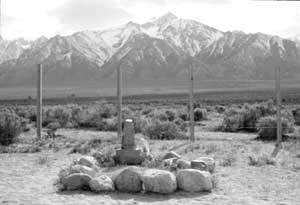|
.gif)

Cover Page
MENU
Table of Contents
Abstract
Acknowledgments
Introduction
Essay
Brief History
Gila River
Granada
Heart Mountain
Jerome
 Manzanar
Manzanar
Minidoka
Poston
Rohwer
Topaz
Tule Lake
Isolation Centers
Add'l Facilities
Assembly Centers
DoJ and US Army Facilities
Prisons
References
Appendix A
Appendix B
Appendix C
|
|
|
|
Confinement and Ethnicity:

An Overview of World War II
Japanese American Relocation Sites
by J. Burton, M. Farrell, F. Lord, and R. Lord
|

|
|
Chapter 8 (continued)
Manzanar Relocation Center
Outlying Area
There are features remaining from virtually all of
the relocation center developments outside the central fenced area. This
includes the cemetery, farm fields and ditches, the chicken and hog
farms, the water supply system, the sewage disposal system, and other
features.
Cemetery

Figure 8.80. Grave at the Manzanar Relocation Center cemetery.
|
The relocation cemetery is located on the west side of the central
fenced portion of the relocation center. At the cemetery there is a
large concrete obelisk with Japanese inscriptions on two sides (Figure
8.79). The inscription on the front (east) side translates as "Monument
to console the souls of the dead" and the inscription on the back (west)
side translates as "Erected by the Manzanar Japanese August 1943."
Around the monument there is a concrete slab and nine concrete posts
shaped and stained to resemble wood. Within the fenced cemetery area
there are 14 rock-outlined plots (Figures 8.80 and 8.81), two with cut
stone markers with inscriptions, two with wood posts, and one with a
small unreadable wooden sign. Also within the fenced cemetery area there
are three concrete foundations for wooden fence posts, one with an
inscription. Across a dirt road north of the fenced cemetery enclosure
there are three rock-outlined pet graves (Figure 8.82).

Photo Album
Continued

|
|
|



 Top
Top
![]()


